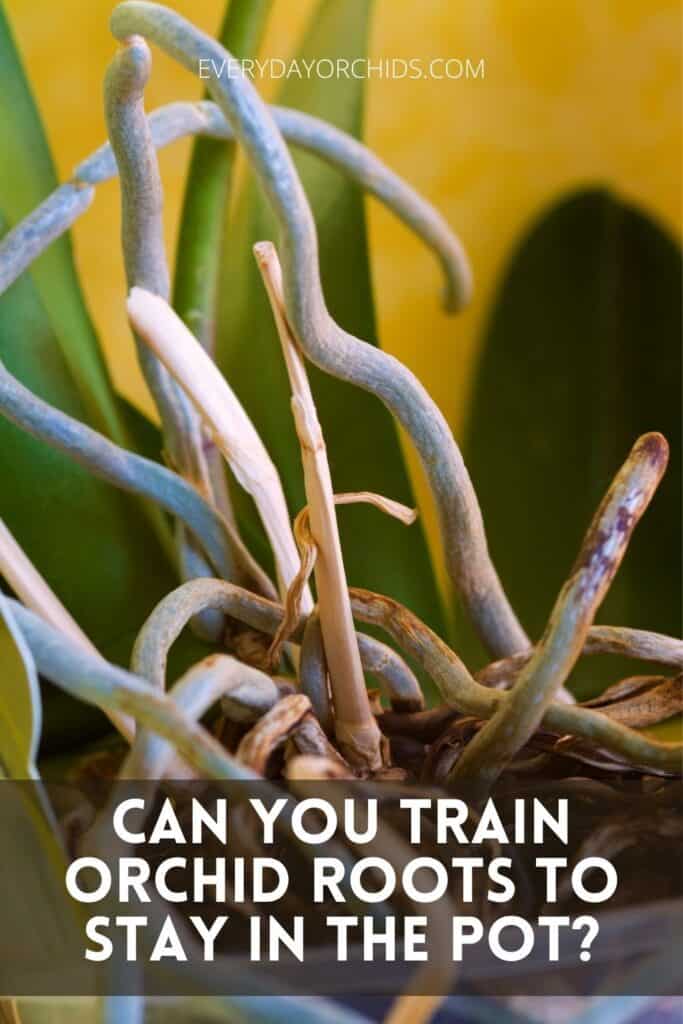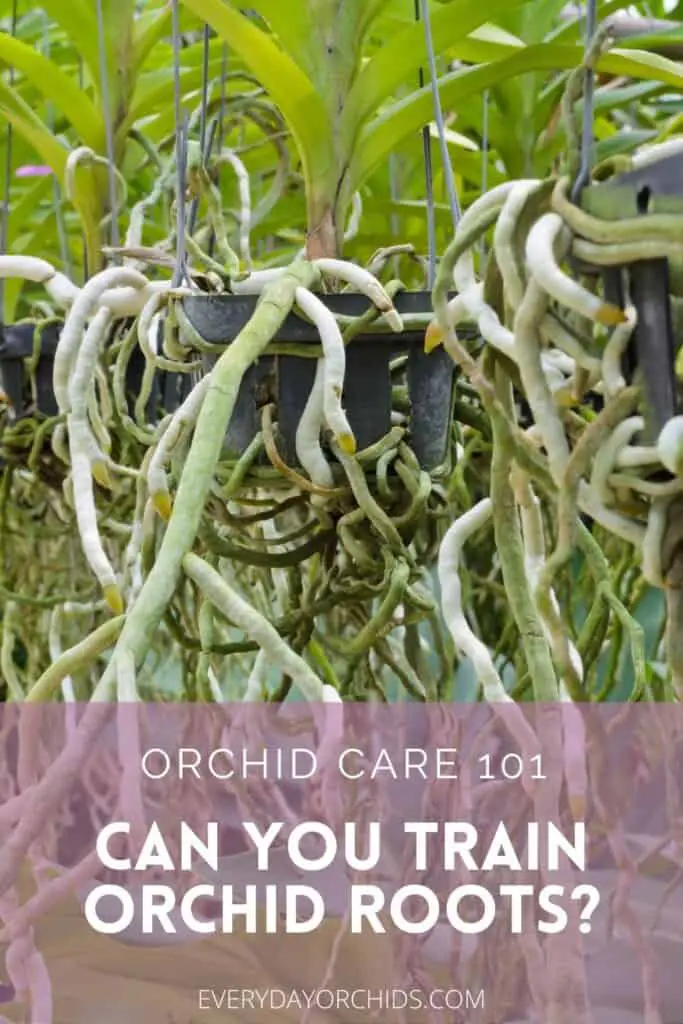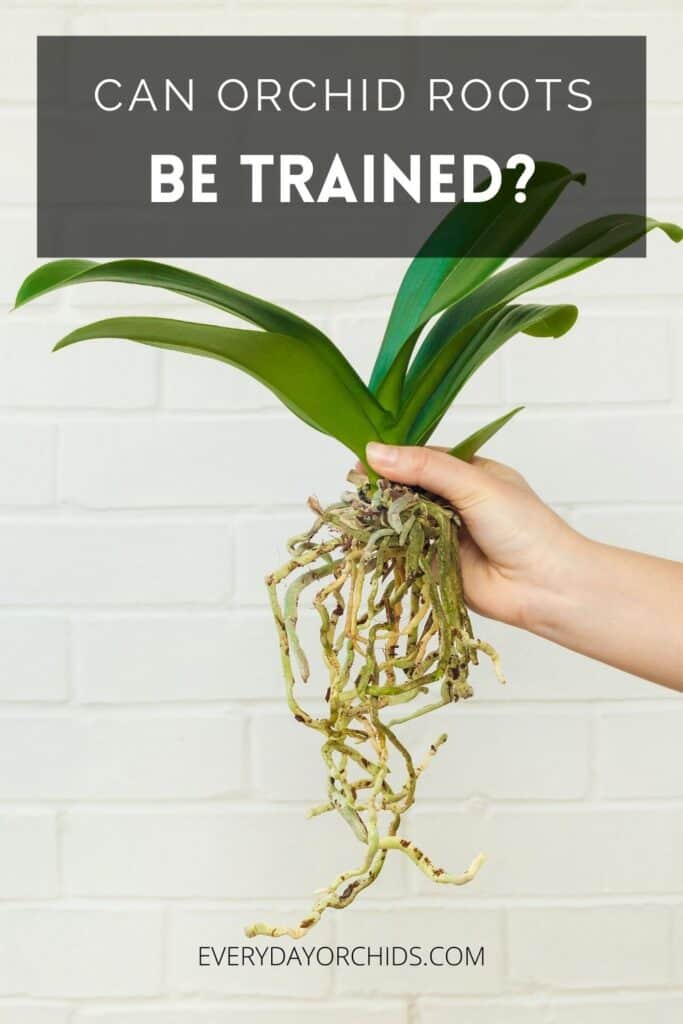If you have a lot of aerial roots growing up and around your orchid’s leaves or pot, you may be wondering if it is possible to train these roots to stay in the pot. After all, your orchid may start to look messy and unkempt due to all the roots growing everywhere. So, can you train your orchid roots to grow down and stay in the pot?
Unfortunately, orchid roots cannot be trained to stay in the pot, especially if these are aerial roots you are wanting to train. These roots have a natural tendency to grow in all directions around the orchid and orchid pot. Attempting to “train” these orchid roots can actually have detrimental effects on the root’s health and the orchid’s health overall.

In this article, I’ll explain more about why orchid roots cannot be trained to stay in the pot, as well as the inherent differences between potted roots and aerial roots. I’ll also talk about which orchid varieties tend to grow more aerial roots. You’ll find out which orchids are better for you if you want to avoid roots that grow everywhere. Plus, even if you can’t train orchid roots, did you know you can, and should, train orchid flower spikes? Keep reading to learn more.
Please note that these links are affiliate links and as an Amazon Associate, I earn from qualifying purchases. Purchases made through affiliate links in this post may generate commissions at no additional cost to you. Use this link for a discounted Amazon Prime trial. Thank you for your support!
Table of Contents
Can Orchid Roots Be Trained To Stay In The Pot?

The short answer to this is no, orchid roots cannot be trained to stay in the pot. Orchid roots love air. Most orchids are epiphytes and their roots naturally grow in all directions.
In nature, epiphyte orchids, such as Phalaenopsis orchids, grow on the sides of trees. Their roots grow in different directions because the orchid uses these roots to secure itself to the surface of the tree bark. The roots also work to absorb moisture and nutrients from the surrounding air.
In the wild, all epiphyte orchid roots are “aerial roots,” and will grow everywhere. This type of root growth is completely natural.
Over the years, we’ve managed to “domesticate” orchids in order to grow them in a pot. This allows orchids to fit better in our homes. However, while most of the time this works, it has also led to other problems such as root rot, degrading potting media, fungus gnats and so on.
The Difference Between Potted Roots And Aerial Roots
Since we now have potted orchids in our homes, the orchid roots can be divided into two categories (even though they are really the same): Aerial roots and potted roots.
You can read more about the different types of orchid roots in another article, but in short, aerial roots are the roots that will grow up and around the orchid and orchid pot. These are the roots that tend to get in the way and make the orchid look “messy.” So can you train these roots to grow down into the pot?
Unfortunately, you can’t train orchid roots to all stay in the pot. Aerial roots have adapted to living outside the pot. They have a thicker layer of velamen and help the orchid absorb moisture and nutrients from the surrounding air.
Aerial roots are also able to perform some photosynthesis for the orchid plant. This ability, along with the thicker layer of velamen, is what sets these roots apart from potted roots.
You want to keep these aerial roots intact because if all the potted roots die, the aerial roots will be what saves your orchid in the end. When you repot an orchid with lots of aerial roots, be careful not to break the roots or push them down into the potting media.
Why Can’t You Train Orchid Roots?
There are a few reasons why orchid roots cannot be trained. Attempting to train the orchid’s aerial roots can cause the roots to die or become damaged. I’ll go into more detail below.
The Aerial Roots May Die
Trying to force aerial roots down into potting media will likely cause those roots to slowly die. They are not adapted to survive in the darker, higher moisture environment. This, right here, is the biggest reason why you should not try to train aerial roots to grow in the pot. Attempting to force aerial roots into the potting media will most likely result in root rot and eventual death.
Some people do try to bury their orchid’s air roots, or aerial roots, into the pot during repotting. I go over why you shouldn’t bury aerial roots here, and what some alternatives are to this practice.
Damage To The Velamen
Secondly, trying to manipulate the orchid root can result in damage to the delicate velamen covering the root. This can, in turn, can impair the orchid’s ability to uptake water and nutrients through its root. Without adequate water, the orchid leaves will start wilting.
Yes, it is true that most of an orchid’s water uptake happens through the potted roots. However, you still want to be cautious when handling aerial roots. Aerial roots are still able to perform basic root functions, so don’t disregard them.
You Might Break The Root
In addition, attempts to bend the aerial roots down can result in breaking or snapping the orchid root. An orchid’s aerial roots are not meant to be bent or manipulated, something you may accidentally do as you try to train the orchid root to grow in a certain direction.
There are ways to soften up the orchid root so that it is more pliable, but this is meant to be done on potted roots, not aerial roots. You can soften potted roots by soaking all the orchid roots in a bucket of water before you repot your orchid. By doing this, the orchid roots will soften slightly and allow for some manipulation to fit into the new orchid pot.
However, I would not recommend attempting this with aerial roots. These roots tend to be tougher, thicker, and grow up and around the leaves. Trying to bend these aerial roots will likely damage or break them.
Plus, in order to soften all the aerial roots, you would likely have to soak the entire orchid in water for an extended time. However, soaking the entire orchid should be avoided for several reasons. For one, getting water in the orchid’s crown can lead to crown rot. In addition, dirty water on the orchid’s leaves can lead to infections such as brown spot.
If you are trying to repot an orchid with lots of aerial roots, and don’t know where to start, read this guide on how to repot an orchid with aerial roots.
Why Is My Orchid Growing So Many Aerial Roots?

Looking at your orchid with its roots growing in every direction, you may wonder why it has so many aerial roots. If there are lots of aerial roots, is the orchid trying to tell you something? Is there something wrong with the potting media?
The answer to that is no, there is nothing wrong with the potting media or your orchid. Lots of aerial roots growing up and around your orchid isn’t necessarily a bad thing. As a matter of fact, many roots, of any kind, signify a happy orchid.
When the environment is ideal and well-humidified, an epiphyte orchid will grow lots of aerial and potted roots. Aerial roots are natural and won’t hurt your orchid. Leave them on your plant.
Don’t Cut Off Or Remove Your Orchid’s Roots Unless They Are Dead
You may have heard of some people trimming off their orchid roots in order to keep the orchid display nice and attractive. Don’t do this!
Don’t cut off aerial roots, trim them or try to train them to grow downward. If you do, you may end up doing your orchid more harm than good.
Cutting off living orchid roots will slow, or stop, your orchid’s growth. Depending on how many roots are cut off, the orchid may or may not recover. It is traumatic and stressful for the orchid, to say the least.
Don’t cut off any roots unless they are dried, shriveled, rotted, or obviously dead. Even when you do cut off dead roots, be sure to use sterilized gardening shears to prevent pathogen transmission.
Another reason why you shouldn’t cut off your orchid’s living roots is, less roots means the orchid is less able to absorb water and nutrients. This is true even if the roots you removed are aerial roots.
Cutting off the root also creates an opening for bacteria and pathogens to enter the orchid. This puts the orchid at risk for disease and infection.
As I mentioned before, if your orchid loses all of its potted roots to root rot, aerial roots become incredibly important. Aerial roots are what you will need to save your orchid that has lost all its other roots. So leave these roots alone!
I go over why you shouldn’t cut off or trim your orchid’s aerial roots in more detail here, so please check that out if you’d like to learn more.
Which Orchids Have Lots Of Aerial Roots
In general, epiphyte orchids will grow aerial roots. This is just how these orchids are. It is completely normal to see a lot of roots growing up around the leaves and over the edges of the pot.
Epiphyte orchids include the popular Phalaenopsis orchid, Oncidiums, and Dendrobiums. Among these orchids, Phalaenopsis orchids and Vanda orchids tend to have thicker aerial roots, while other orchids such as Oncidiums and Dendrobiums tend to grow thinner aerial roots.
If you happen to own a Vanda orchid, these orchids are notorious for having an abundance of long orchid roots that grow outside the pot. For these particular orchids, you would be best off mounting your Vanda orchid to a tree outdoors.
Alternatively, you could hang the pot from a pergola or a ceiling hook in the corner of the greenhouse or garden. This would allow the orchid roots to freely hang down. Having lots of aerial roots is normal for Vanda orchids and to be expected. You should not cut these roots.
Which Orchids Don’t Have Aerial Roots
If you prefer to have an orchid that doesn’t grow any aerial roots, look into growing terrestrial orchids. These orchids grow best in rich, loamy, well-draining soil. While they are typically grown outdoors as part of a garden bed, they can also be grown indoors in a pot.
Examples of terrestrial orchids include Cymbidium orchids, Spathoglottis orchids, Bletilla ground orchids, and Lady Slipper orchids. These are popular orchids that are also relatively easy to care for. Since they are terrestrial orchids and not epiphytes, their roots tend to grow down into the ground.
What Can (And Should) You Train On Your Orchid Instead?
If you are looking to train something on your orchid, train your orchid’s flower spikes instead! In fact, if you have a Phalaenopsis orchid, it is highly recommended that you train your orchid’s flower spike.
Training the orchid flower spike is also known as staking it and securing it to a support. This is necessary in some orchids to prevent the orchid from becoming too top-heavy from the blooms.
Unsupported or untrained orchid flower spikes have a higher risk for falling over. This is due to the weight of the orchid blooms leaning to the side.
You can also train orchid flower spikes to grow in different shapes and spirals, for a unique design twist. If you are interested in learning how to do this, check out Everyday Orchids’ guide on how to create spiraled and shaped orchid flower spikes. Please note that this is best done with Phalaenopsis orchids.
Final Thoughts
So, all that said, unfortunately, you can’t train orchid roots to grow downward and stay in a pot. Just know that these particular roots that are growing up and around your orchid are serving a special function. They are also a sign of a healthy orchid.
You’ll just have to live with your orchid’s aerial roots growing in every direction…which is not necessarily a bad thing! If you prefer, you could also switch to an orchid whose roots stay underground, such as a terrestrial orchid.
If you enjoyed this article, please pin it and share!





